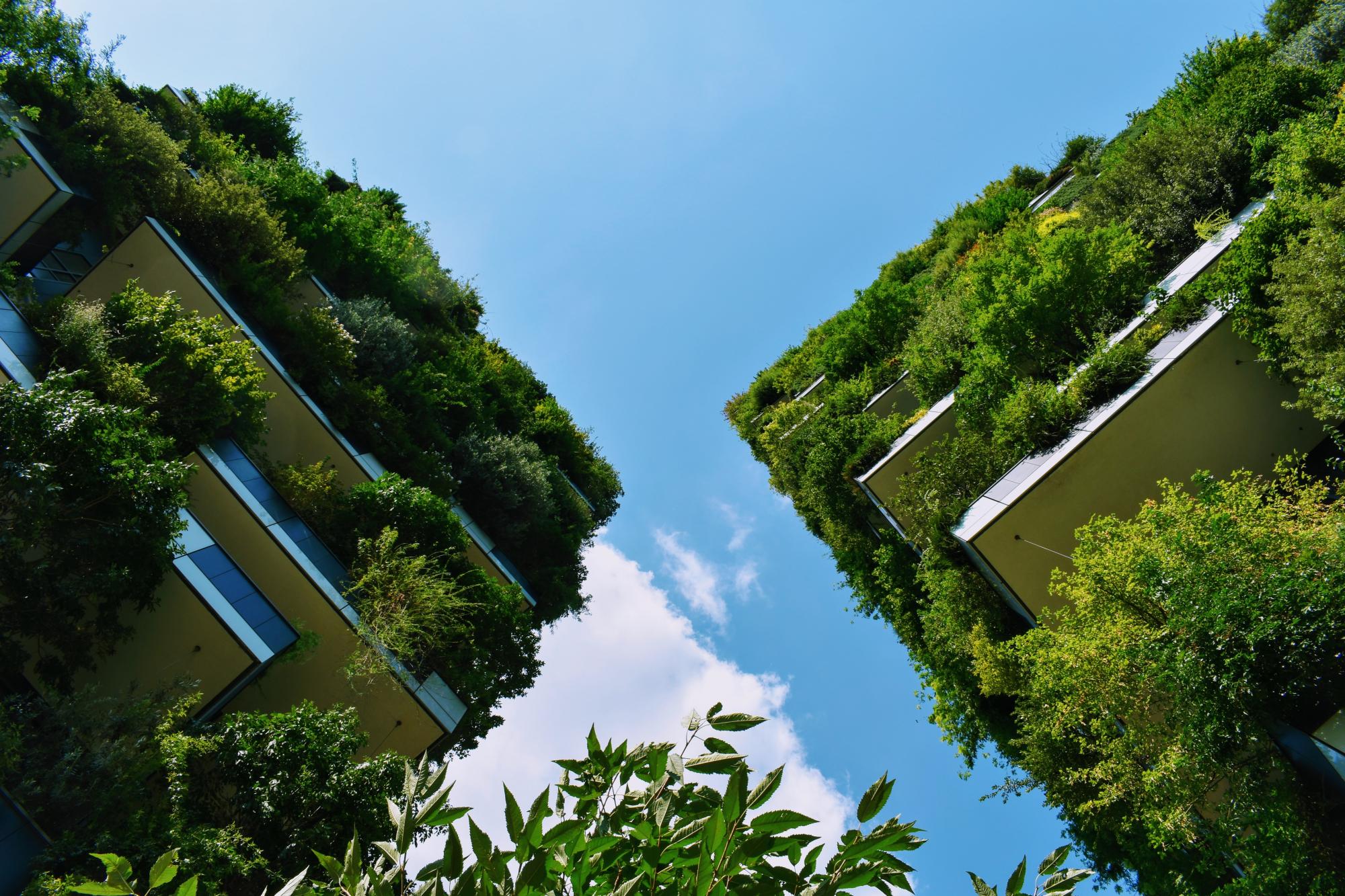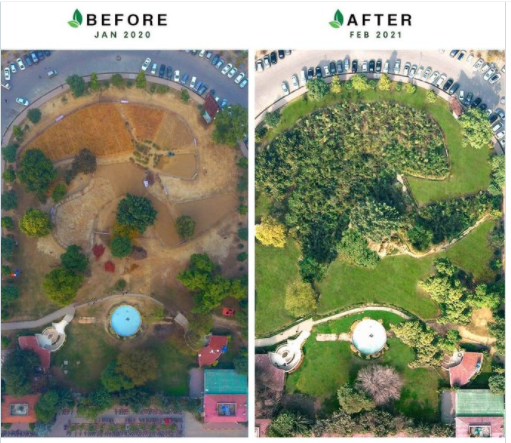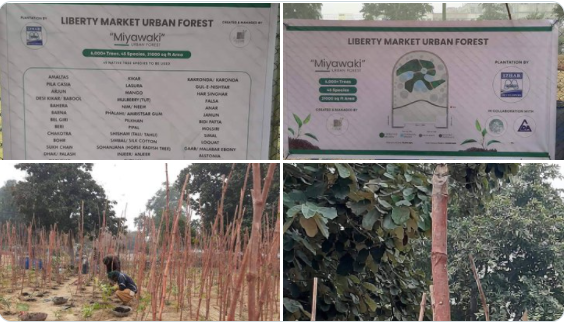Last updated: November 2021
As part of the "Urban Forest Policy", the first Miyawaki urban forest was created in an area of 2,850 square meters in Lahore, Pakistan. The initiative was a result of a public-private partnership between Lahore Development Authority (LDA) and Restore Green. The project was carried out under the PM Khan 10 billion tree plantation drive. Miyawaki is a technique pioneered by Japanese botanist Akira Miyawaki, which helps build dense, native forests. The approach is supposed to ensure that plant growth is 10 times faster and the resulting plantation is 30 times denser than usual. It involves planting dozens of native species in the same area and becomes maintenance-free after the first three years. [1, 2, 3]
Overview
Nature-based solution
- Parks and urban forests
- Large urban parks or forests
Key challenges
- Climate action for adaptation, resilience and mitigation (SDG 13)
- Climate change adaptation
- Climate change mitigation
- Green space, habitats and biodiversity (SDG 15)
- Habitat and biodiversity restoration
- Green space creation and/or management
- Environmental quality
- Soil quality improvement
- Air quality improvement
- Regeneration, land-use and urban development
- Promote natural styles of landscape design for urban development
- Cultural heritage and cultural diversity
- Preservation of natural heritage
- Protection of historic and cultural landscape/infrastructure
Focus
Creation of new green areas
Project objectives
1. To bring back the city's historical green spaces.
2. To reduce the heat island effect, air pollution and contribute to carbon storage.
3. To improve habitat for local species and help in increasing biodiversity.
4. To contribute to the PM Khan 10 billion tree plantation. [1, 2, 4]
Implementation activities
In an area of 2,850 square meters, 10,000 saplings were planted. All these plants are from the native varieties. A total of 45 native types of trees were chosen. [2, 5]
Climate-focused activities
Climate change adaptation:
- Increase or improve urban vegetation cover to help reduce outdoor temperature
- Create or improve outdoor spaces to help people escape from urban heat
Climate change mitigation:
- Increase green urban nature for carbon storage (wetlands, tree cover)
- Improve carbon sequestration through selection of more adaptable species
Biodiversity conservation or restoration-focused activities
Biodiversity restoration:
- Rehabilitate and restore damaged or destroyed ecosystems
- Restore species (native, endangered, or unspecified)
- Restore native species
Main beneficiaries
- National-level government
- Local government/Municipality
- Citizens or community groups
Governance
Management set-up
- Co-governance with government and non-government actors
Type of initiating organisation
- National government
- Local government/municipality
- Non-government organisation/civil society
Participatory approaches/ community involvement
- Unknown
Details on the roles of the organisations involved in the project
A public-private partnership between Lahore Development Authority and Restore Green, funded by Izhar-Monnoo Developers and supported by Afforestation Lahore. [4, 7]
Project implemented in response to ...
... an EU policy or strategy?
No
... a national policy or strategy?
Yes
(PM Khan 10 billion Tree project [1, 2])
... a local policy or strategy?
Unknown
Financing
Total cost
Unknown
Source(s) of funding
- Public national budget
- Public local authority budget
Type of funding
- Earmarked public budget
- Direct funding (grants, subsidies, or self-financed projects by private entities)
Non-financial contribution
Unknown
Impacts and Monitoring
Environmental impacts
- Climate change
- Lowered local temperature
- Enhanced carbon sequestration
- Environmental quality
- Improved air quality
- Improved soil quality
- Green space and habitat
- Promotion of naturalistic styles of landscape design for urban development
- Increased green space area
- Increased conservation or restoration of ecosystems
- Increased conversion of degraded land or soil
- Reduced biodiversity loss
Economic impacts
- Reduce financial cost for urban management
Socio-cultural impacts
- Social justice and cohesion
- Improved access to urban green space
Type of reported impacts
Expected impacts
Presence of formal monitoring system
Unknown
Presence of indicators used in reporting
No evidence in public records
Presence of monitoring/ evaluation reports
No evidence in public records
Availability of a web-based monitoring tool
No evidence in public records
References
1. Tweet by PM Imran Khan. (2021) URL: Source link Accessed on 10th November, 2021.
2. Youtube Video bySoch Videos. (2021). Making Lahore Green Again. Source link on 10th November, 2021.
3. Khabarnaamaa (2020). Now Lahore has its own Urban Forest. URL: Source link. Accessed on 10th November, 2021.
4. Dawn (2019). Forest to be developed on Liberty Park. URL: Source link. Accessed on 10th November, 2021.
5. Youtube Video by Salman Travel Diaries (2021). Urban Forest in Liberty Market, Pakistan. URL: Source link. Accessed on 10th November, 2021.
6. Pakistan Today (2021). Lahore gets urban forests on Japanese model to fight air pollution. URL: Source link. Accessed on 10th November, 2021.
7. Arif, Y. (2021). Liberty Market forest: an urban forest in Pakistan. The Nature-Based Solutions Initiative. The University of Oxford. URL: Source link. Accessed on 10th November, 2021.
8. Mangi, F. (2020). A 10 Billion-Tree Plan Is Restoring Pakistan’s Lost Forests. The Bloomberg. URL: Source link. Accessed on 12th November, 2021.
2. Youtube Video bySoch Videos. (2021). Making Lahore Green Again. Source link on 10th November, 2021.
3. Khabarnaamaa (2020). Now Lahore has its own Urban Forest. URL: Source link. Accessed on 10th November, 2021.
4. Dawn (2019). Forest to be developed on Liberty Park. URL: Source link. Accessed on 10th November, 2021.
5. Youtube Video by Salman Travel Diaries (2021). Urban Forest in Liberty Market, Pakistan. URL: Source link. Accessed on 10th November, 2021.
6. Pakistan Today (2021). Lahore gets urban forests on Japanese model to fight air pollution. URL: Source link. Accessed on 10th November, 2021.
7. Arif, Y. (2021). Liberty Market forest: an urban forest in Pakistan. The Nature-Based Solutions Initiative. The University of Oxford. URL: Source link. Accessed on 10th November, 2021.
8. Mangi, F. (2020). A 10 Billion-Tree Plan Is Restoring Pakistan’s Lost Forests. The Bloomberg. URL: Source link. Accessed on 12th November, 2021.
Information about this nature-based solution was collected as part of the UNA global extension project funded by the British Academy.


